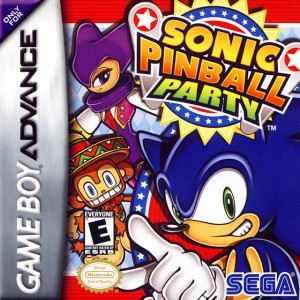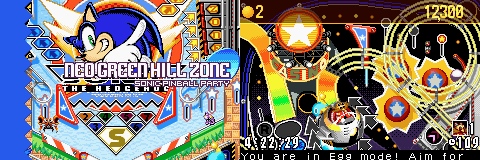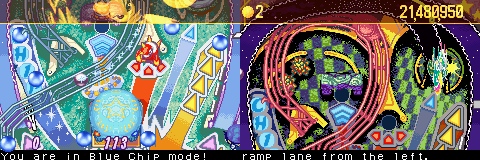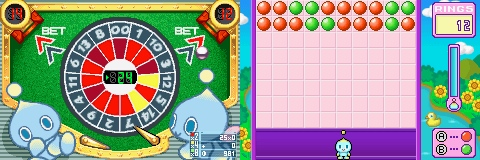Time Capsule: Sonic Pinball Party
Over a year ago, a former NintendoEverything writer started a series of “Time Capsule” articles taking a look back at games we have fond memories of. While others might choose to take a look at something like Star Fox 64 or Super Metroid, we all have different ideas of what qualifies as a “classic” game. And that’s why I’ll be taking a look at game that no-one but me would ever call a “classic”: Sonic Pinball Party. Yep, It’s definitely an unconventional pick, since —let’s be honest— the title makes it sound like shovelware riding on the persistent popularity of Sega’s spiky mascot, but I swear it’s one of the best titles for the Game Boy Advance.
The game was released back in 2003, at a time where Sonic showing up on a Nintendo console was still about as strange as, say, a Pokemon game on a SEGA console. Sonic Pinball Party wasn’t the hedgehog’s first foray into the world of pinball, but unlike Sonic Spinball, Pinball Party looks and plays more like a traditional pinball game. That said, it really doesn’t feel like just another pinball game with a Sega-styled coat of paint. Instead, Sonic Pinball Party takes the concepts behind the Sonic the Hedgehog series, as well as NiGHTs and Samba de Amigo and attempts to apply them to a genre where the only control method is a pair of flippers. The merge of classic Sega titles and pinball elements doesn’t always work out perfectly, but Sonic Pinball Party still manages to be simultaneously* the best Sonic, NiGHTs and Samba de Amigo game released in the last ten years.
*Completely subjectively
Since he’s the only character who actually made it into the title of the game, it makes sense that the Sonic the Hedgehog table is the one that you’ll probably play the most. It’s the table that’s most frequently revisited in the game’s “story” mode, which consists of a few challenges tied together by a nonsensical story. Basically, Dr. Eggman kidnapped a bunch of animals and then decided to host a pinball tournament; inviting Sonic and just about every character Sonic Team have ever created. The only way Sonic can free them is to… beat Eggman at pinball? To be fair to the writers, Eggman is pretty damn good at pinball, so his plan almost makes sense.
Anyway, the Sonic table is incredibly enjoyable, but definitely the most generic. That said, there are plenty of touches that make the table uniquely “Sonic.” Like the games themselves, there are lots of loops on the table, and going around them in rapid succession will net you a tonne of points or even extra balls. It wouldn’t be a Sonic game without all his annoying friends, so there’s also a character-change mechanic that changes the bonus “mini-game” you get whenever you sink enough balls into the “Chao Drive.” Lighting up all the lights that spell “EGG” causes Eggman to descend from the sky for a boss fight. Beat him up within the time limit and it’s off to the next zone —but not before doing several speedy loops of the table to help rack up a massive score. There are a lot of nice visual touches as you move into different zones and the music changes as well. Granted, most of the music is lifted from Sonic Advance, but there are few remakes of “classic” Sonic tunes that sound great despite the limited sound capabilities of the Game Boy Advance. I think it’s safe to recommend any soundtrack that makes Sonic R’s music even remotely listenable.
Besides appearing in a brief downloadable minigame included with Phantasy Star Universe, Sonic Pinball Party marks NiGHT’s first appearance since his (???) original game on the Sega Saturn. The core mechanic in the NiGHTs table, just like in the Saturn game, is to “dualize” the ball with NiGHTs. Once dualized, your creepy-jester-thing infused ball can collect blue chips (which act exactly the same as the Sonic table’s rings), complete objectives in “mini-game” mode and collect enough “Ideya” to face off against one of several Nightmaren bosses. OK, so the boss battles aren’t particularly challenging, but they are interesting in the way that they completely change the layout of the table, plus the soothing rendition of “Dreams Dreams” that plays when you beat them makes playing this table more than worth it.
The most interesting aspect of the NiGHTs table is the “Acrobat Mode.” Basically, when you enter this mode, you have to use your ball to pull off various tricks, like launching it from one end of the table to the other or bouncing it off parts of the environment. It’s unique to this table and it really captures the original NiGHTs game’s focus on pulling off elaborate tricks for points. Overall, the NiGHTs table is much more creative than Sonic’s and is probably the easiest of all three, mainly because the ball saver stays in effect for ages.
The final table, based on the Dreamcast (and later, Wii) rhythm game, Samba de Amigo, is unlocked through the “story” mode. It’s easily the most creative of the tables, but it’s also the most unforgiving. The ball constantly ends up in the exit lanes, and triggering ball savers can be tricky. There are two main ways to earn points here: through “Song Play” mode, or “Fever” mode. Song Play mode requires you to shoot balls in specific directions, but in keeping with Samba de Amigo’s rhythm game genre, you’ll have to time it with the song playing in the background.
If Song Play mode is an attempt to apply Samba de Amigo’s game mechanics to pinball, then Fever mode is the complete opposite. Once all the FEVER lights at the bottom the screen are lit, a minigame begins where you have to shake maracas in time with music —essentially a watered-down version of Samba de Amigo. There are only two buttons used (presumably to keep with the game’s “flipper-only” control scheme) and the actual songs are often poorly synched to the action onscreen. Still, it’s certainly a creative addition, especially if you start to get bored of traditional pinball. Hitting the bumpers at the top of the table (modelled after the various “poses” you have to pull off in the original game) allows you to change the song choice. There’s a bunch of tracks from various Sonic Team games (except Ristar) and they all sound great. It’s just a shame that those songs are really the only reference to titles like Chu-Chu Rocket and Phantasy Star Online. Where’s my Burning Rangers table? Even if the punishing difficulty and constant looping of Vamos A Carnaval will definitely get on your nerves, it’s tough not to enjoy such a happy-looking table. Plus, the tracks in the Song Play and Fever modes are fantastic!
If there’s one major flaw with Sonic Pinball Party, it’s that the actual pinball physics are far from perfect. The ball feels too floaty, but ultimately the physics feel a lot tighter than other pinball games on the GBA like Pokemon Pinball and Super Mario Ball. You can tilt the table around as much as you like, but it never feels cheap —probably because it’s the only thing that makes games on the Samba de Amigo table last longer than five minutes.
Outside of pinball, there’s a bunch of easily-exploitable gambling minigames under the “Casinopolis” mode. The coins earned from gambling can be used to feed a pet Chao in the same Tiny Chao Garden mode that appeared in the first two Sonic Advance titles. It’s cute, but there’s not much point to it, especially if you don’t own either of the Sonic Adventure games for the Gamecube. If it wasn’t obvious from the title, pinball is definitely what the game does best.
By all accounts, Sonic Pinball Party was exclusive to Target stores in the US, but it was later made available at other retailers after it was paired with several other Sega games for the Game Boy Advance. There are a few varieties of “double pack” out there, with Sonic Pinball Party paired with the also-excellent Sonic Advance, the merely-OK Sonic Battle, and the complete trainwreck that is Columns Crown. Any version of the game is relatively cheap, so it’s worth tracking down if you have any affection for the franchises references or are just after a great game to play in short bursts. Personally, it’s been in the bottom slot of my Nintendo DS for the last two years.
Titles like Sega Superstars Tennis and Sonic and Sega All-Stars Racing show that Sega are throwing their old characters in any genre, but in Sonic Pinball Party they actually complement the whole pinball experience quite nicely. Yes, there’s a heap of Sonic Team fanservice, but there’s an incredibly well made pinball game underneath all that. If you can overlook a few flaws like a tacked on story mode and physics that don’t feel quite right, you’ll find that Sonic Pinball Party is one of the most underrated titles for the Game Boy Advance. Just don’t say that I didn’t warn you about that Samba de Amigo stage.




